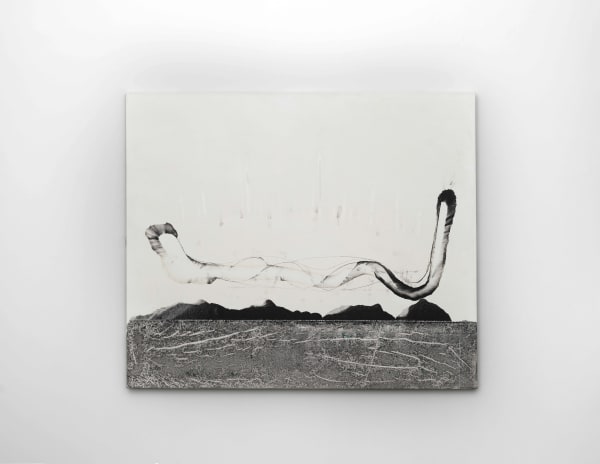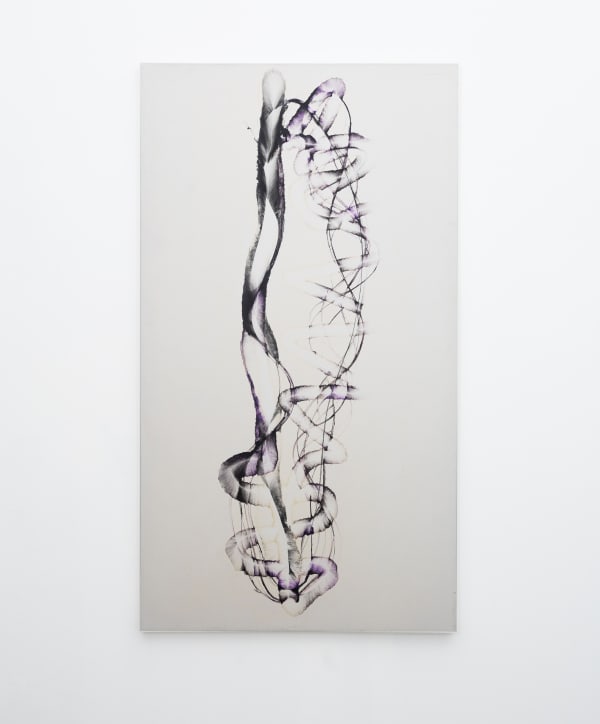-
-
Herbert Creecy
Made in space: paintings from 1992 - 2001
Johnson Lowe Gallery is pleased to present Made in Space: Paintings from 1992 -2001, a solo exhibition of never-before-exhibited works by Herbert Creecy. On view from February 21, 2025 – March 29, 2025, the exhibition highlights a selection of paintings from 1992–1997, a period in which Creecy pushed his process into new conceptual and material territory. Made in Space offers a rare look at the artist’s late explorations with polyurethane transfers and air compressors, revealing a body of work where spatial fragmentation, levitation, and architectural form converge.
-
-
For half a century, Herbert Creecy worked at the edges of recognition, a prolific and restless painter who lived and moved deeper in the South while the center of critical discourse remained elsewhere. His canvases—layered, scraped, collaged, and often monumental in scale—were never fixed things. They were built up, broken down, and reassembled in a process that felt equal parts instinct and strategy. If his early works, with their fingerpaint-like squiggles, were collected by the Whitney, the Corcoran, and the High Museum, it was because they slotted neatly into the wider history of American postwar abstraction. But Creecy was never interested in slotting in. From the Shakin’ Shanties of the 1980s to the cannibalistic, his most celebrated self-consuming collages of the 1990s, each series fed off the last, absorbing and repurposing past gestures until the work, and the artist, collapsed under the weight of constant reinvention. He produced over 3000 paintings, but for all their ambition, they remained largely underexamined. The research simply never caught up to the work.
-
Astral inquiry—an overarching theme throughout the vast oeuvre of the late Herbert Creecy—expounds upon realms beyond the physical world, often linked to consciousness, dreams, or higher dimensions. The desaturated black-and-white tones embody the vast, uncharted expanse of the cosmos. Creecy’s polyurethane transfers channel tactile textures that echo the surface of distant, uncharted worlds—drawing parallels to the moon's rugged terrain.
The technical intricacies of the polyurethane transfers are fundamental to the physical nuance of his work. Composition in Line, Shape, and Texture, features this element in grander-scale, the delicate balance of pressure, timing, and materiality plots surfaces capturing the essence of celestial bodies.
Herbert Creecy’s dense and exuberant paintings employ a range of experimental techniques that were ahead of his time. Though widely known for his “squiggles”, the scope of Creecy’s oeuvre demonstrates his immense ingenuity and technical virtuosity. Wildly prolific, his imagery and influences were unbounded by traditional constructs. He often re-purposed and painted over canvases to unearth new compositions, pushing the spatial boundaries of the traditional picture plane. Creecy’s methodology allows his work to maintain its integrity and complexity in almost all orientations. What always remains is a pure painterly expression of an internal landscape.
-
-
Made in Space presents a different side of Creecy. The paintings here, most never before exhibited, date from 1992 to 2001, when space, form, and the tension between impulse and structure became the focus. Paint wasn’t just pushed and pulled anymore; it was transferred, compressed, displaced. Polyurethane lifts and air compressor bursts replaced the brush. These works took on a new kind of precision.
-

-
In the work of Herbert Creecy, a central approach to mark-making operates within the ubiquitous machinery of technology. In pieces like Untitled (Black and White Compressor Composition) and Untitled (Black and Purple Composition), Creecy’s intrigue with the technological becomes a pivotal element in his compositions — the mechanical force of an air compressor becomes an extension of his process, using it to maneuver throughout the canvas.
The compressor steers air into cylindrical volumes, diffusing acrylic and oil paints in methodical structures. In Untitled (Black and White Compressor Composition), Creecy has utilized pressure from the air compressor to spread swaths of black and white pigment in horizontal striations, which embed onto the surface and within the body of the canvas. Similarly, Untitled (Black and Purple Composition) uses the same technology to create a rhythmic cadence of purple and black. The work pulses, its forms intertwining and dancing in an elliptical motion – like a cocoonic DNA strand.
Creecy’s inventive use of technology establishes a foundation for forms that shift between the engineered and the biological, as if constructing a gene sequence instructing the precision of his tools with the fluidity of life.
-
Selenographic surfaces, referencing the mapped features of the Moon’s surface, takes shape in In Two Dimensions. The term selenography is derived from "Selene," the Greek goddess of the Moon, and "graphy," meaning the study or mapping of. Creecy conjures the personification of the Moon, building upon the canvas to evoke an esoteric landscape. This interplay between light and texture, where cosmic forces oscillate with tangible form, embodies the Moon’s eternal presence in the universe, merging myth with scientific inquiry into a unified vision. Creecy maps out craters, mountains, and plains, while flashes of color flare within the composition—reminiscent of an aurora or supernova—radiating the essence of lunar regolith.
Throughout each of the works in this room, each transfer is unique, with fluctuations in texture and transparency that heighten the sense of depth and dimensionality, reverberating a vision of celestial journey.
-
-
-
Creecy never quite abandoned Abstract Expressionism, but by this point, he had retooled it. These paintings weren’t just responding to their own internal logic—they were in conversation with the ideas of their time. The tension between modernist faith in materiality and postmodern skepticism toward gesture and authorship is embedded here. Creecy, for all his embrace of improvisation, was always aware of where his work stood in relation to both histories. And these paintings move between them. They don’t just exist in space—they map it, construct it, erode it. Across them, Creecy doesn’t simply compose; he builds, excavates, displaces. And in the end, the work hovers, just as it always has, between fact and fiction, between the terrestrial and the aerial, between gesture and the ghost of a gesture.
-

Herbert Creecy
Untitled (Shifting Clay), 1989 - 1997Herbert Creecy’s Untitled (Rust and Violet) and Untitled (Shifting Clay) are two unique works in Herbert Creecy’s current exhibition. These works move away from structure of the dominant series of works in the exhibition, and into atmosphere. Pigment accumulates like sediment, dissolves into liquid depth, drifts into planetary suspension. If the earlier works feel engineered, these feel eroded, their forms shifting between micro and macro, geologic and cosmic, cellular and celestial. -

Made in Space: Paintings from 1992 - 2001: Herbert Creecy
Current viewing_room




